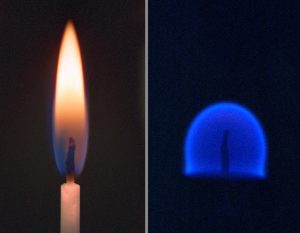
Comparison of flame under different gravity conditions. The flame on the left is in 1G, the flame on the right in microgravity. (Credits: NASA).
According to NASA, microgravity can affect smoke particles in ways that make it difficult for detectors to differentiate between a bonafide fire and harmless dust. To advance understanding of this phenomenon, researchers from NASA’s Glenn Research Center flew the Smoke Aerosol Measurement Experiment (SAME) aboard ISS first in 2007 and again in 2011.
“SAME had various spacecraft materials that we would overheat to make smoke. We sampled the smoke with devices that were set up to measure the particle size distribution. That, in turn, could allow us to develop a reliable and accurate early warning system,” said David Urban, principal investigator for the experiment at NASA’s Glenn Research Center.
Smoke detectors currently aboard ISS are based on Earth models that were designed to operate in 1G conditions. Early stage fires in microgravity are thought to produce more complex smoke than seen on Earth, as well as more likelihood of dust contamination in space where dust does not settle under gravity. The detectors must also take into account that burning different materials produces different smoke characteristics. For example, hydrocarbon fuels typically produce soot; plastics produce droplets of recondensed polymer fragments; and paper and silicone rubber produce smoke comprised of liquid droplets of recondensed pyrolysis products. Each of these materials produces a different type of smoke, with particles of various sizes and properties.
Research from the SAME experiment could be used on Earth as well. A reliable portable sensor could be invaluable to first responders and in confined spaces such as submarines. “Accurate detection of smoke in these environments can save lives,” said NASA developer Paul Greenberg.
The video below recounts the one occurence of uncontrolled fire to have occurred in space aboard the Mir space station.
sp;
































![A trajectory analysis that used a computational fluid dynamics approach to determine the likely position and velocity histories of the foam (Credits: NASA Ref [1] p61).](http://www.spacesafetymagazine.com/wp-content/uploads/2014/05/fluid-dynamics-trajectory-analysis-50x50.jpg)



Leave a Reply